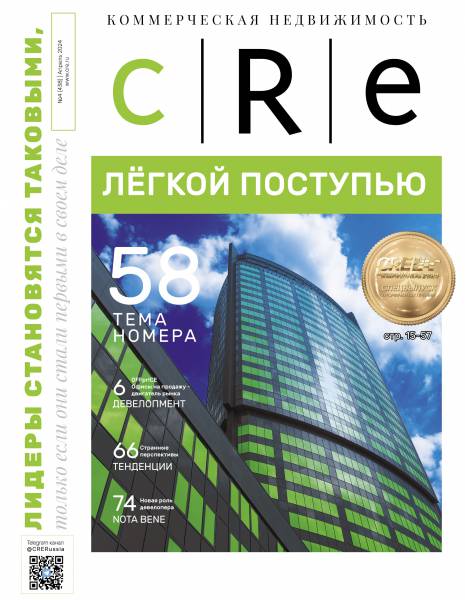The free market turned everything over 180 degrees. The majority of guidelines are no longer of an imperative character, but one of recommendation, buildings are constructed according to individual author projects, architects are given practically total carte-blanche, while tenants have solely individual requests, which can be seen, among other things, in the design of premises. One of the results of this “creative freedom” multiplied by “individual requests” was the emergence of commercial properties suffering from loss-syndrome, namely large and unjustified losses of useful space. The “doctors” – meaning architects and developers – are trying to defeat this sickness, prescribing their medicine, but the treatment is proving difficult and costly.
In principle, the so-called “lost spaces” are an attribute of any project. As noted by Sergey Kanaev, commercial director at Nagatino i‑Land, these are hallways, elevator lobbies, heating rooms and other technical spaces with utilities equipment unsuitable for renting. Also included in the “lost” spaces are the facilities of the management company, cleaning inventory and security. We’ll note once again that all this cannot be avoided. It’s a separate matter that, as the expert emphasizes, “according to international standards, the loss coefficient in high-quality, class A, B + and B – should not exceed 20 %. For class A offices, the hallway coefficient is acceptable in the range of 12–18 %, for class B – under 20 %. In warehouse real estate, this coefficient can be larger than in offices.”
There are several international standards serving as the basis for calculating the coefficient of the loss of useful space in office buildings and other commercial properties, but the most famous and broadly used is the BOMA standard. BOMA (Building Owners and Managers Association) is a North American organization of office real estate owners, which since 1916 has published the standard that de-facto became the main method in the sphere of valuing commercial office and retail real estate. The most recent edition of the BOMA standard published in early 2010 is an expanded and improved version of the previous standard. “In modern office buildings, the coefficient usually takes a value from 1.05 to 1.25. It depends upon the size of the entryway, width of stairways, hallways, elevator lobbies, and other factors,” says experts at MKV Architects.
Unfortunately, the reality, at least in Russia, is especially far from the ideal: the country has a surfeit of properties in which the coefficient of useful space loss is extremely high. Furthermore, as highlighted by Natalia Legotina, head of her own architecture bureau, “such buildings can be found among new, recently built commercial real estate properties, as well as among properties of Soviet development and the pre-revolutionary period.” According to Sergey Kanaev, the buildings of the former SRIs could serve as the clearest examples here. For example, at the Experimental SRI of metal-cutting machines at 5 Donskoi proezd, up to 30 % of the space is occupied by the front stairwell.
Who’s guilty?
What leads to the uncontrolled growth of the loss-factor, and what are the typical mistakes? With reference to the edifices built long ago, the situation can be characterized as extremely difficult. Elena Lisina, deputy director of strategic consulting and valuation division at CBRE, laments that “the old buildings built erected under Soviets mainly have an office system where the losses on hallways can total up to 30 %. Furthermore, the old buildings quite frequently have an ineffective column grid, ineffective location of stairway-elevator spaces, which complicates the renovation of these properties.” According to the expert, a separate segment is comprised of office mansions – usually built during the pre-revolutionary period. “These buildings, as a rule, are ineffective from the standpoint of design solutions, Elena Lisina argues. “Usually, such properties are architectural monuments with substantial restrictions on changing the inside design solutions and facades.”
However, if the old buildings have justifications in the form of those architectural-design approaches that were commonplace during the period of their construction, then the “losses of modernity” cannot be justified by anything, except for the developers’ mistakes and gross misclaculations of architects. Natalia Legotina lists the following:
– ill-conceived distance of load-bearing columns;
– “incorrect” building shape (for the optimal use of office space, rectangular-shaped buildings are ideal, the others being fraught with a large number of corners, protrusions, load-bearing columns, etc.);
– misconceived designs at the stage of construction;
– location of the main load-bearing columns misconceived at the stage of drafting;
– retrofitting the infrastructure of the building itself: overly spacious entryway, entrances with concierges, overly spacious lobbies and recreational areas, changing rooms for service personnel, etc. – all this is calculated for building users, not each specific tenant, who is forced to pay for space that in fact they don’t use;
Furthermore, senior project manager, project management division at Jones Lang Lasalle, Dmitry Chupakhin is certain that “what leads to a high coefficient of lost space are a tall building height, the combination of different functions in a single building, and extravagant design. As a rule, this results from the incorrect selection of architect and/or developer.” “Frequently, when designing, the architects working on the project try to proceed not from the building’s functional designation, but from its architectural image,” elaborates Ivan Podkova, director of marketing department at GC REGIONS. Furthermore, the mistakes arise due to the lack of a single center of decision making, responsible for project realization. In the long term, this necessitates the allocation of additional spaces in the building for utility facilities of one kind or another.” But when it comes to retail space, here, as noted by Dmitry Konovalov, general director at TEKTA GROUP, “the losses happen because of the utilities infrastructure. For example, the design of the premises may include an overly spacious ventilation chamber.”
Yet in all fairness, it should be noted that quite frequently a high coefficient does not mean that the building was designed unskillfully and is unsuitable. As noted by Alexander Khorosh, lead expert for BOMA standards at MKV Architects, “many class A buildings have a large number of recreational areas, wide hallways, and “more air.”
Who needs this?
Now is the ideal time to ask: why are all these measurements even made and for whom is the ratio of overall and “lost” space so important? The answer lies in the financial domain – the lessor receives and the lessee pays money accounting for the building’s coefficient. “For example, if the lessee occupies 100 sq.m of space, then under a coefficient of 1.15 calculated according to the BOMA standard, he will pay for 115 ‘squares,’” Sergey Kanaev explains. “Therefore, the lower the coefficient value, the more effectively the space is used and the higher is the property’s attractiveness factor. Besides the building’s coefficient, the BOMA standard also includes the storey coefficient, which proportionally divides the storey’s total space among tenants.”
As Elena Lisina emphasizes, ‘the owner tries to include as much space as possible among the rentable spaces and thus to receive income from these spaces. And here the BOMA calculations appear to be the most preferable for the tenant: in accordance with this standard, the main vertical spaces (stairways, elevator lobbies, pipes, smokestacks, vertical air passages, etc.), the walls separating them and atriums are not included in the storey’s rentable space.” According to the expert, “the most effective buildings from the standpoint of lost space for the tenant are buildings with open designs and storey space of at least 1000 sq.m, with column webs of at least 8 x 8 m or 9 x 9 m and with the location of stairway-elevator lobbies and bathrooms in the storey’s center. In this case, the storey can easily be split between several tenants with minimal losses of space.”
And yet, as noted by the specialists at Capital Group, the use of BOMA standards and calculations in accordance with this standard are for now a practice far from commonly accepted in Russia: “in Russia on the whole it is still the BTI standard that is used, according to which the construction companies are obligated to provide the city with data on the amount of space.”
And how to combat this?
Whatever your belief, the mandatory “lost” spaces are an objective matter and one has to reconcile with this, whereas additional ones are an unpleasant matter and this is to be combated. According to the experts at Capital Group, “this matter acquires particular relevance during the construction of modern skyscrapers: the more comfortable the conditions created for the property’s users are, the greater the risk of lost space. At MUC Capital City, the amount of effective spaces totals roughly 70 %. For a class A building with spacious common areas, several elevator lobbies and complicated utilities, this indicator is high.”
Natalia Legotina suggests that the developers at least minimally use the hallway-office system, and ideally only for the upper top-management and VIP conference rooms; ideally suitable for the remaining employees are office partitions of modern materials. “In cases when total sound isolation is necessary, it’s possible to use ceiling sound-catchers, etc. An office combining the advantages of the hallway-office structure with the capabilities of open-space are ideally suitable for any company. In addition, it’s not worth using standard furniture.” Providing further unexpected advice is Sergey Kanaev, who suggests inviting a managing company with a large portfolio – in this case, the building owners won’t have to allocate to the managers large additional premises for inventory and technical services. But overall it’s clear that rational approaches and “elimination” of unjustified “show-offs” are fully capable of reducing the loss-factor to a reasonable minimum.
There are also prescriptions in cases of reconcepting rather than new construction. Elena Lisina notes that reducing the loss coefficient in already existing buildings is possible by means of optimizing design solutions – for example, demolition of load-bearing partitions. Examples of the reconstruction of office buildings erected during the Soviet period include BC Nagatinsky and BC Tupolev-Plaza. Among the numerous successful examples it’s possible to include the redevelopment as office properties of former manufacturing facilities (for example, Danilovskaya manufactory, Krasnaya Roza).
Elkan Kerimli, managing director at Renaissance Development, recalls that in their practice there were successful redesigning solutions: “Extraneous hallways were closed (not fire escapes, of course). Dead corners were turned into premises. To the extent that height allowed, a second level was made inside the premises, although this wasn’t planned at the drafting phase.”
However, all the experts without exception are certain that chasing after minimizing the loss-factor is highly dangerous and requires great caution. Otherwise, the retail centers that are ever more frequently playing the role of “cultural centers” risk turning into retail areas of the market type, while office buildings remain without an architectural-image component, which for many tenants is extremely important.
не указано
Tale of Lost Spaces
During the times of democratic centralism, when all the construction sphere was strictly regulated by SNIPs, GOSTs and other guidelines, both those who built buildings and those who later occupied them knew in advance “where, whither and how much.” Prototypes of premises were planned out once and for all, organizations sat in them for years, changed location only by special decision from above, while for newly settled organizations only cosmetic renovation was completed.
16.09.2012

771


Коментарии (0)
Чтобы ответить войдите









